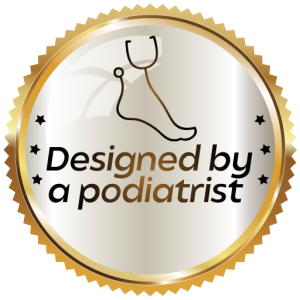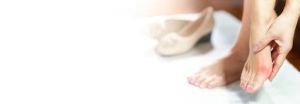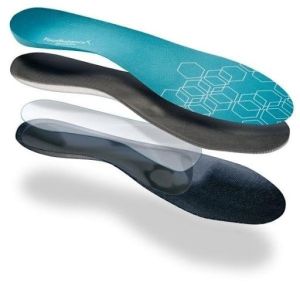



Bunion pain is a common condition that causes significant discomfort and limits the ability to wear shoes comfortably, negatively impacting the lives of those affected. Many wonder about effective ways to relieve bunion pain. Therefore, in this article, we will explore strategies for pain reduction, focusing on the role of insoles, and provide practical advice for improving foot health and achieving functional comfort.
A bunion is a bony bump that forms at the base of the big toe joint. It occurs when the big toe gradually deviates towards the other toes, causing the joint to protrude outwards. This deviation and protrusion can cause friction and pressure from shoes, leading to inflammation and pain, making the bunion hurt when walking or even at rest in advanced cases.
Several factors contribute to bunion formation, including genetic predisposition, wearing tight or high-heeled shoes for long periods, and some types of arthritis.

There are several symptoms that can be associated with a bunion, including pain, swelling, and redness around the joint. The big toe may also be difficult to move. In some cases, bunions can also cause problems with wearing shoes, as they may rub against the inside of the shoe and cause irritation.
If you are experiencing any of these symptoms, you may have a bunion. It is important to see a doctor so that they can diagnose the problem and recommend treatment. Wearing insoles in your shoes can help to relieve some of the pain associated with bunions.

There are several methods that can be followed for how to help with bunion pain and reduce the associated discomfort. These strategies include a range of home measures and lifestyle changes, as follows:
There are many ways to treat a bunion, but one of the most effective ways is to use insoles. Insoles can help to realign your foot and take pressure off of the bunion. They can also help to cushion your foot and reduce pain. Here are some step-by-step instructions for using insoles to treat your bunion pain:

While there are many different types of insoles available on the market, it is important to choose a pair that fits well and provides the right level of support for your individual needs. If you suffer from bunions, you may want to consider a pair of insoles that are designed specifically for this condition.
When selecting a pair of insoles, make sure to take into account the type of shoes you will be wearing. For example, if you plan on wearing them in dress shoes, you will need a different type of insole than if you were planning on wearing them in sneakers. Additionally, pay attention to the size and shape of your feet when choosing an insole, as this will ensure a comfortable and customized fit.
If you are not sure which type of insole is right for you, consult with a podiatrist or other foot health professional. They will be able to assess your individual needs.
Insoles, or bunion shoe insoles, are important tools that can contribute to relieving bunion pain and providing comfort. These insoles, especially specially designed bunion insoles, work to redistribute pressure away from the affected big toe joint, provide arch support, and offer additional cushioning for shock absorption.
These insoles can help improve foot alignment and reduce stress on the bunion while walking, thereby reducing inflammation and pain. They are available in various types to suit different shoe styles and support needs.
Regarding insoles to prevent bunions, it is important to clarify that insoles alone may not completely prevent bunion formation, especially if there are strong genetic factors or continued wear of unsuitable shoes. However, insoles that provide good arch support and help maintain proper foot alignment can reduce abnormal stress on the big toe joint, potentially contributing to slowing the development of bunions or delaying their appearance.
True prevention requires a comprehensive approach that includes choosing appropriate footwear from a young age and avoiding factors that increase the risk of bunion formation.
Many wonder how to cure bunions naturally or permanently without surgery. The truth is that a bunion is a structural change in bones and joints. Therefore, a “cure” in the sense of completely restoring the joint to its normal position without surgical intervention is unlikely in most advanced cases. However, non-surgical measures, including using insoles, changing footwear types, and stretching exercises, can significantly contribute to managing symptoms, relieving pain, improving foot function, and slowing the progression of the condition.
The goal of non-surgical treatments is to enable the person to live with the bunion with minimal pain and discomfort.
Relieving bunion pain is a realistic goal that can be achieved by adopting a comprehensive set of effective strategies. Choosing appropriate insoles from Lifebalance is a key element within these measures. Additionally, meticulous foot care and selecting suitable footwear play a vital role in improving health status and reducing the discomfort associated with this condition.
Surgery is usually considered when bunion pain is severe and persistent, significantly affecting a person’s ability to perform daily activities, and the condition has not responded to other non-surgical treatments such as changing shoes, using insoles, and medications. A specialist doctor will evaluate the condition and determine if surgery is the most appropriate option.
The ideal shoe for bunion patients should have a wide and deep toe box that does not press on the bunion or toes. It is preferable for it to be made of soft, flexible materials, have a low heel not exceeding 2-3 cm, and provide good arch support and adequate cushioning.